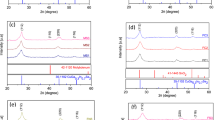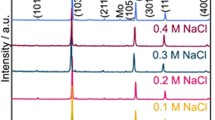Abstract
CuIn(Se x S1−x )2 thin film is prepared by the electrodeposition method for the absorption layer of the solar cell. The CuIn(Se x S1−x )2 films are characterized by cyclic voltammetry measurement for the reduction of copper, indium, selenium and sulfur in selenium and sulfur in aqueous solutions with sodium citrate and without sodium citrate. In the four cases, the defined reduction process for every single element is obtained and it is observed that sodium citrate changes the reduction potentials. A linear relationship between the current density of the reduction peak and (scan rate v)1/2 for copper and indium is achieved, indicating that the process is diffusion controlled. The diffusion coefficients of copper and indium ions are calculated. The diffusional coefficient D value of copper is higher than that of indium, and this is the reason why the deposition rate of copper is higher. When four elements are co-deposited in the aqueous solution with sodium citrate, the quaternary compound of CuIn(Se x S1−x )2 is deposited together with Cu3Se2 impure phases after annealing, as found by XRD spectra. Morphology is observed by SEM and AFM. The chemical state of the films components is analyzed by XPS. The UV-Visible spectrophotometer and electrochemistry workstation are employed to measure the photoelectric properties. The results show that the smooth, uniform and compact CuIn(Se x S1−x )2 film is a semiconductor with a band gap of 1.49 eV and a photovoltaic conversion efficiency of 0.45%.










Similar content being viewed by others
References
P. Luo, Z. Liu, Y. Ding, and J. Cheng, A Novel Non-vacuum Process for the Preparation of CuIn(Se,S)2 Thin-Film Solar Cells from Air-stable, Eco-Friendly, Metal Salts Based Solution Ink, J. Power Sources, 2015, 274, p 22–28
P.U. Londhe, A.B. Rohom, and N.B. Chaure, CuInSe2 Thin Film Solar Cells Prepared by Low-Cost Electrodeposition Techniques from a Non-aqueous Bath, RSC Adv., 2015, 5, p 89635–89643
J.C. Malaquias, D. Regesch, and P.J.D.M. Steichen, Tuning the Gallium Content of Metal Precursors for Cu(In, Ga)Se2 Thin Film Solar Cells by Electrodeposition from a Deep Eutectic Solvent, Phys. Chem. Chem. Phys., 2014, 16, p 2561–2567
A.B. Rohom, P.U. Londhe, and N.B. Chaure, The Effect of pH and Selenization on the Properties of CuInSe2 Thin Films Prepared by Electrodeposition Technique for Device Applications, J. Solid State Electrochem., 2015, 19, p 201–210
G. Li, W. Liu, Y. Liu, S. Lin, Y. Zhang, Z. Zhou, Q. He, and Y. Sun, The Influence of Cracked Selenium Flux on CIGS Thin Film Growth and Device Performance Prepared by Two-step Selenization Processes, Sol. Energy Mater. Sol. Cells, 2015, 139, p 108–114
M. Powalla, P. Jackson, and W. Witte, High-Efficiency Cu(In, Ga)Se2 Cells and Modules, Sol. Energy Mater. Sol. Cells, 2013, 119, p 51–58
B. Koo, R.N. Patel, and B.A. Korgel, Synthesis of CuInSe2 Nanocrystals with Trigonal Pyramidal Shape, J. Am. Chem. Soc., 2009, 131, p 3134–3135
S.J. Ahn, K.H. Kim, and K.H. Yoon, Nanoparticle Derived Cu(In, Ga)Se2 Absorber Layer for Thin Film Solarcells, Colloids Surf. A Physicochem. Eng. Asp., 2008, 313–314, p 171–174
J. Xiao, Y. Xie, Y. Xiong, R. Tang, and Y. Qian, A Mild Solvothermal Route to Chalcopyrite Equaternary Semiconductor CuIn(Se x S1−x )2 Nanocrystallites, J. Mater. Chem., 2001, 11, p 1417–1420
W. Hsu, H. Hsiang, and S. Yu, Crystallite Formation Mechanism of CuIn(Se, S)2 Synthesized Using Solvothermal Method, Ceram. Int., 2015, 41, p 3208–3213
C.D. Lokhande and S.H. Pawar, Electrodeposition of Thin Film Semiconductors, Phys. Status Solidi A, 1989, 111, p 17–40
J.C. Liou, C.C. Diao, J.J. Lin, Y.L. Chen, and C.F. Yang, Prepare Dispersed CIS Nano-Scale Particles and Spray Coating CIS Absorber Layers Using Nano-scale Precursors, Nanoscale Res. Lett., 2014, 9, p 1–7
D.B. Mitzi, M. Yuan, W. Liu, A.J. Kellock, S.J. Chey, V. Deline, and A.G. Schrott, Hydrazine-based Deposition Route for Device-Quality CIGS Films, Thin Solid Films, 2009, 517, p 2158–2162
T. Yamaguchi, T. Naoyama, H.S. Lee, A. Yoshida, T. Kobata, S. Niiyama, and T. Nakamura, Preparation of CuIn(S, Se)2 Thin Films by Thermal Crystallization in Sulfur and Selenium Atmosphere, J. Phys. Chem. Solids, 2005, 64, p 1831–1834
W. Liu, D.B. Mitzi, M. Yuan, A.J. Kellock, S.J. Chey, and G. Oki, 12% Efficiency CuIn(Se, S)2 Photovoltaic Device Prepared Using a Hydrazine Solution Process, Chem. Mater., 2010, 22, p 1010–1014
T. Whang, M. Hsieh, and Y. Kao, Studies of Single-Step Electrodeposition of CuInSe2 Thin Films with Sodium Citrate as a Complexing Agent, Appl. Surf. Sci., 2010, 257, p 1457–1462
L.A. Kosyachenko, X. Mathew, P.D. Paulson, V.Y. Lytvynenko, and O.L. Maslyanchuk, Optical and Recombination Losses in Thin-Film Cu(In, Ga)Se2 Solar Cells, Sol. Energy Mater. Sol. Cells, 2014, 130, p 291–302
G. Chen, B. Pan, L. Jin, G. Jiang, W. Liu, and C. Zhu, Compression for Smoothing and Densifying CuInSe2 and Cu2ZnSnSe4 Thin Films Coating from Oxides Nanoparticles Precursor, J. Alloys Compd., 2014, 610, p 20–26
D.W. Ayela, W. Su, C. Wu, C. Shiau, and B. Hwang, Amorphous Precursor Compounds for CuInSe2 Particles Prepared by a Microwave-Enhanced Aqueous Synthesis and Its Electrophoretic Deposition, Cryst. Eng. Commun., 2014, 16, p 3121–3127
Acknowledgments
This work has been supported financially by National Natural Science Foundation of China (Grant No. 21506043).
Author information
Authors and Affiliations
Corresponding authors
Rights and permissions
About this article
Cite this article
Li, L., Yang, X., Gao, G. et al. Electrodeposition Process and Performance of CuIn(Se x S1−x )2 Film for Absorption Layer of Thin-Film Solar Cells. J. of Materi Eng and Perform 26, 5333–5340 (2017). https://doi.org/10.1007/s11665-017-2978-y
Received:
Revised:
Published:
Issue Date:
DOI: https://doi.org/10.1007/s11665-017-2978-y




